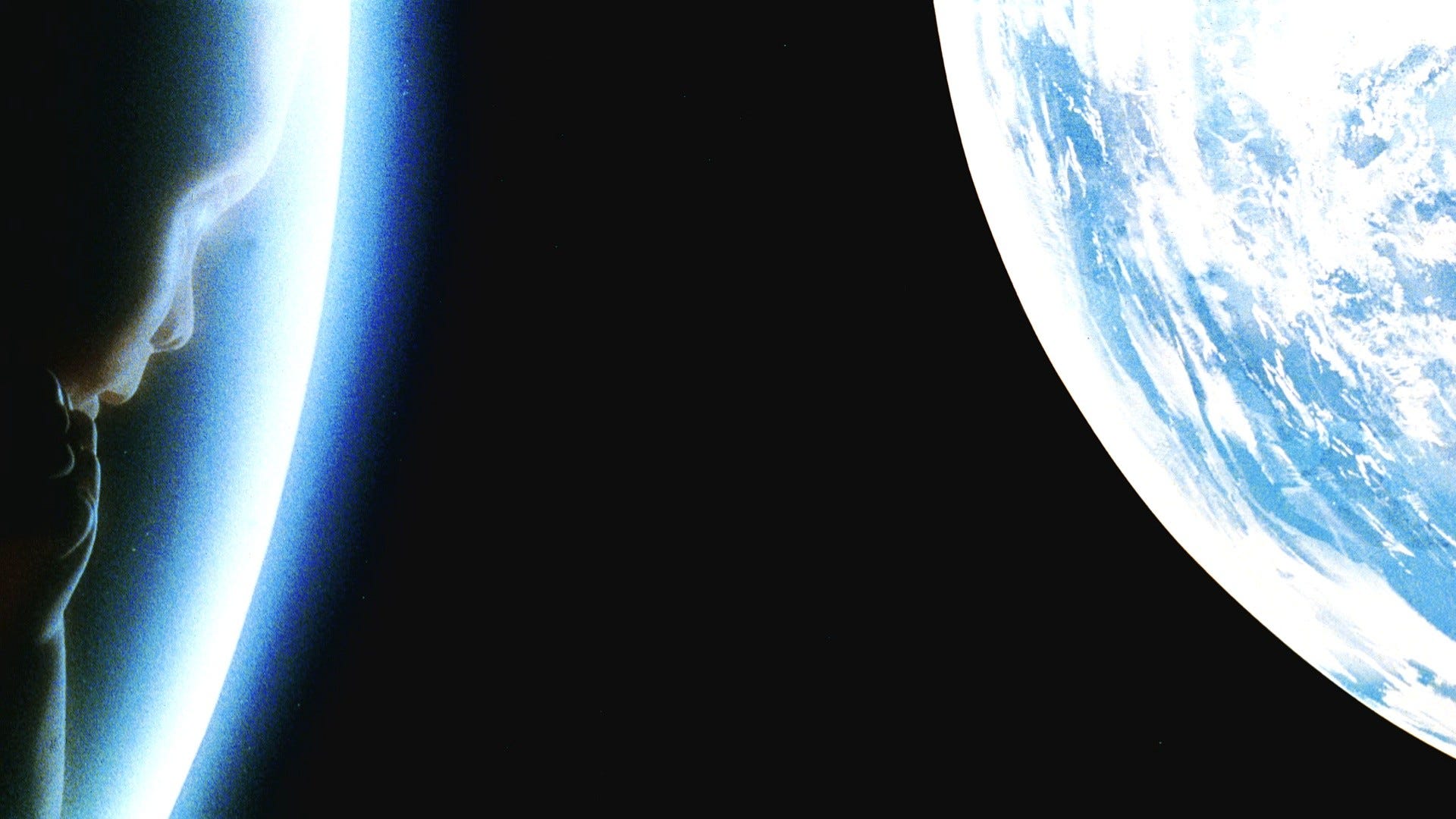
The Cosmic Fetus
In the end of Stanley Kubrik’s *2001 Space Odessey *we see an image popularly called “the cosmic fetus.” It symbolically represents the cross-modal analogic synthesis of a fetus in the womb and the earth in space. Both are bodies.
In 2020, the Jet Propulsion Laboratory published an image of a cosmic baby, an infant magnetron, only about 240 years old--- extremely young, when considered against a cosmic backdrop close to a billion years.
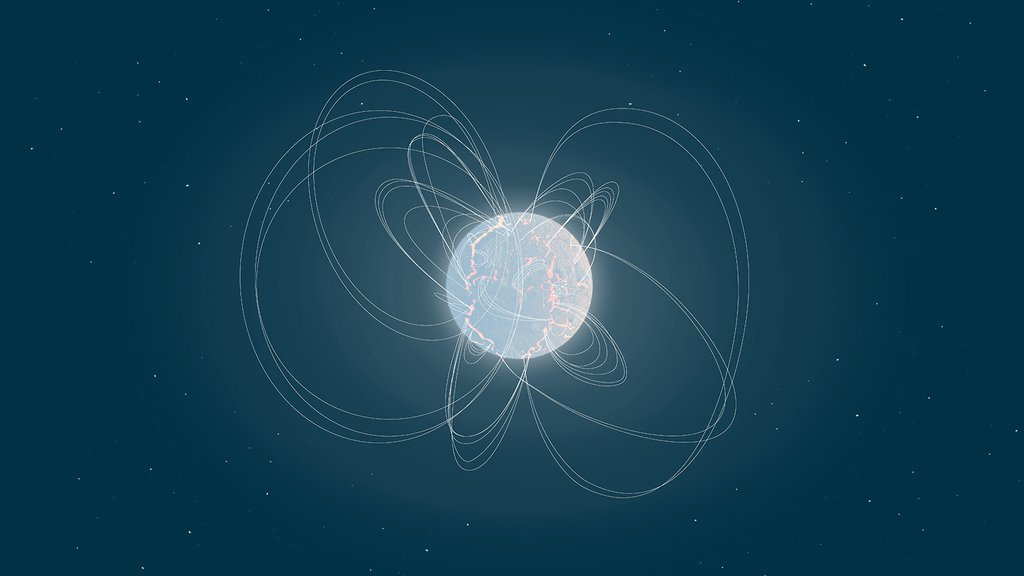
Alan Watts describes the life force of planets, in this humorous little video:
In 2013, the Plank cosmology probe released a the mission’s first all-sky image of the cosmic background radiation, dubbed “a post-big bang baby picture.”
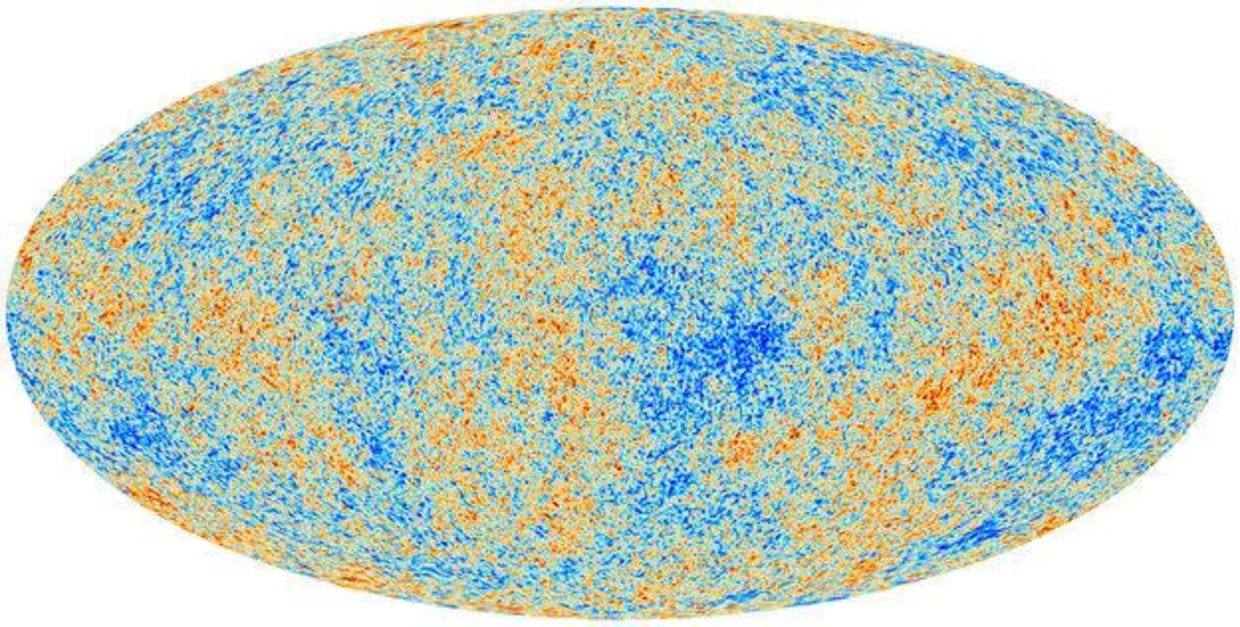
Returning again to Alan Watts, describing the polarity we set up between “prickly” ones (the scientists, engineers, architects) and the “gooey” ones (the spiritual, religious and artistic) …
And here we have a “standard” interpretation of human evolution
We have to be very cautious with this conventional way of looking at evolution. It resembles a developmental sequence in which the prior forms are no longer there. But in evolution, the earlier forms are still here, along with us, evolving. The tree has many branches, some break and fall, some flourish and bear fruit, some are new start-ups budding from the broken ends of other branches. One branch doesn’t come from another branch. All the branches come from the tree unfolding from the seed. The way we tell the story of evolution is pre-loaded with the conclusion that we are the be-all and end-all of a great cosmic plan. Is there really a top branch? No. All the branches branch from the trunk.
Let me tell the story of evolution that is closer to the truth. The universe evolves for some billions of years. Along the way it experiments with different forms. Some of the forms have been here all along, like the primary particles. Some of the forms go in and out of existence very fast, like when matter and anti-matter collide. Some of the forms have evolved great complexity. Many of the most complex forms in the past, like the great fisheds of the Cambrian explosion, have not persisted. Every single form that exists has been evolving for the same amount of time. Some forms have barely mutated --- like the Ginko tree which has been around for 290 million years, and the horseshoe crab which has been around for 440 million years. The bacteria have been around for 3 billion years, but they have many more mutations than most species. Certain species are undergoing rapid mutation due to biological engineering. Not all these mutations are genetically engineered, some of them a the result of cellular navigation in morphogenetic space (I am thinking of the planaria in Michael Levin’s lab which derive strategies to overcome barium poisoning.)
We also like to tell the story of evolution with the Earth as the central protagonist. This is of course, most important perspective for us. But what if we zoom out, and see the Earth and her companions, journeying through space, as an evolving ecology?
What about the grand flows of galaxies toward local attractors, and the entire energy system of Laniakea?
Zooming out, we don’t see most of the universe making the same experiment as here on earth. We see something larger, grander in scale. What if we contemplated on Laniakea and asked: what is the telos of the universe? Is it toward “complexification” as we understand it, up our branch of the evolutionary tree here on earth? Why are all those bodies in space, orchestrating themselves in this way? Where are we going? Who shall we become? Whither, O God?
Stratified Reality and Epistemic Constraints
When pondering such questions, we immediately bump into the constraints of the human mind. We can’t think without categorizing in some way or other. That reality is stratified is one thing. To say that reality is primarily stratified in this way is another. The first is to say that reality is differentiated in meaningful ways--- that there are differences in degree, and differences in kind. Differences in degree compose spectra within the same family. Difference in kind establish new families. Are all differences in kind actually differences in degree that we cannot detect or understand? This is a case of epistemic constraint.
The story we tell about the origins of the body are over-determined by the epistemic categories we use. Because of epistemic constraint, there is no pre-ordained or axiomatic way to chose the correct epistemic categories. We have the freedom to employ reasonable categories that lead to the kind of story we chose to tell. If we want to emphasize human exceptionalism, and justify anthropocentricism --- we can use the categories of levels and hierarchy of species. But I can argue,as I have above, that these categories are not reasonable, given what we actually observe. Therefore I am suggesting a new set of categories. Let’s build a matrix of them. The matrix has two axes: a vertical dimension and a horizontal dimension.
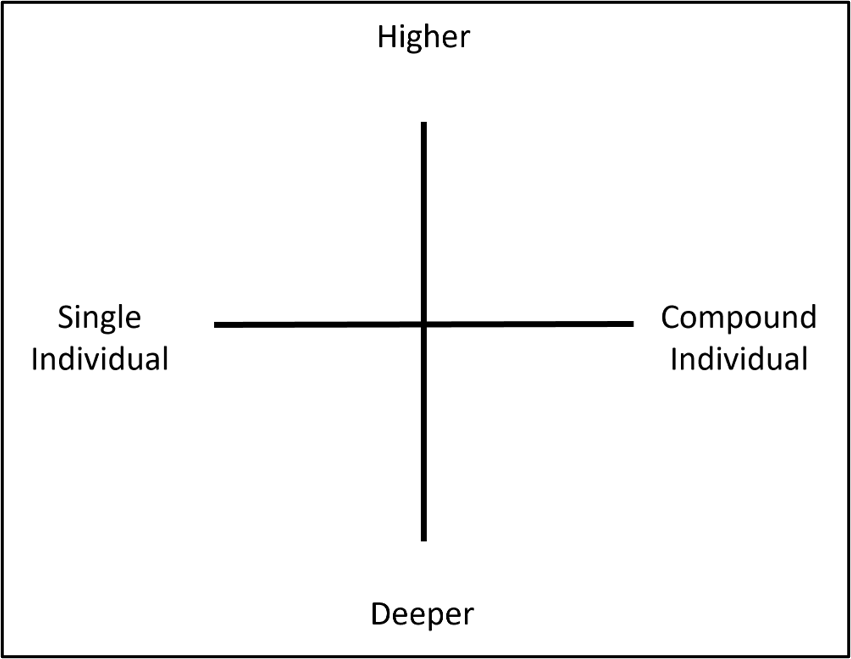
The horizontal axis goes from “single individual” to “compound individual.” For example, the cells in my body are “single individuals” that compose me, the “compound individual.” Of course, there is an infinite recusion here, since the molecules in each cell, construed as “single individuals” compose the “compound individual” that is the cell, hence:
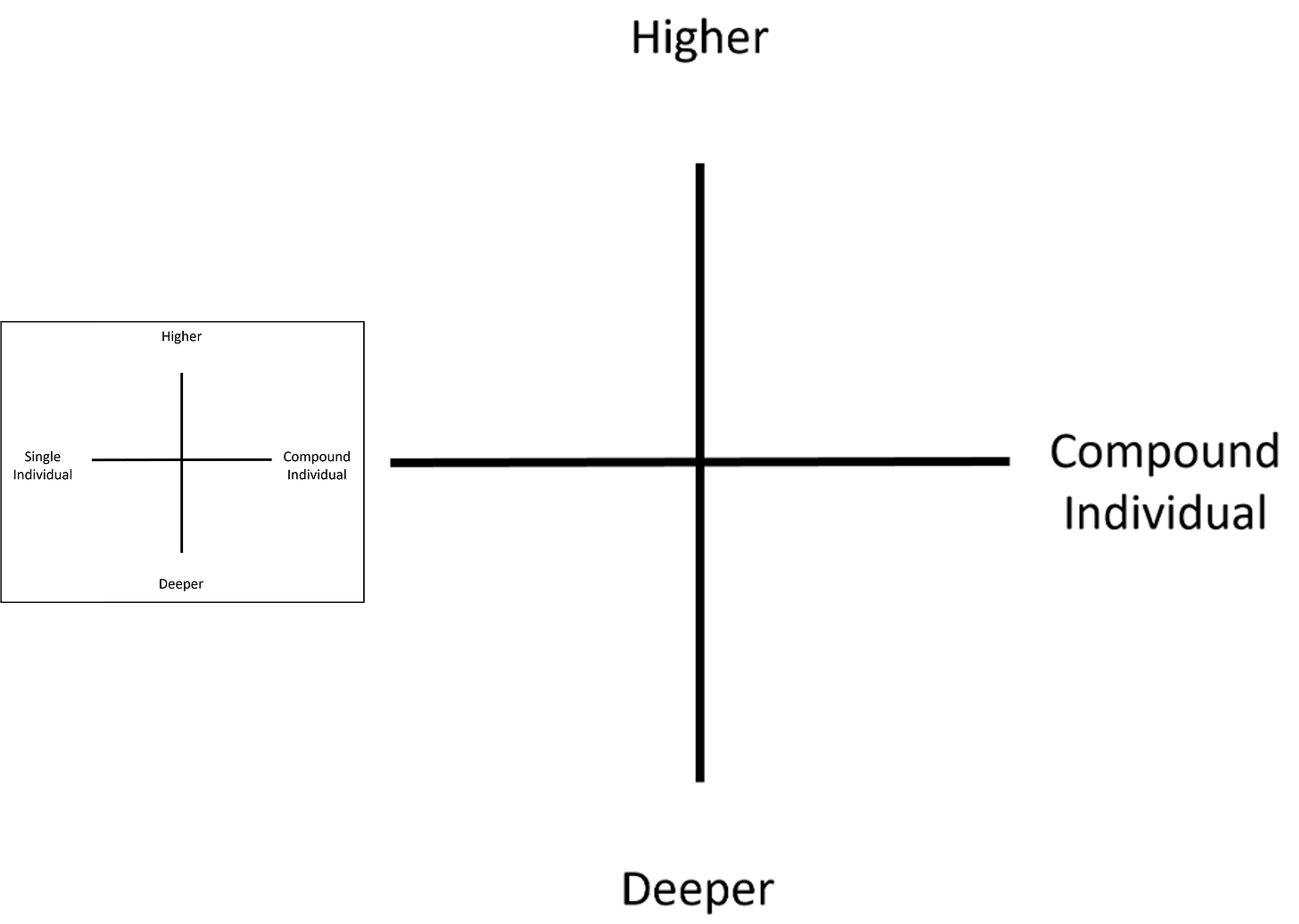
Now consider the vertical axis with “deeper” at the bottom and “higher” at the top. This represents collectives of “individuals” (who are actually compounded) that create different orders of intelligence, or some might say, “information processing.” given any single individual, there is a kind of “cognitive bowtie”
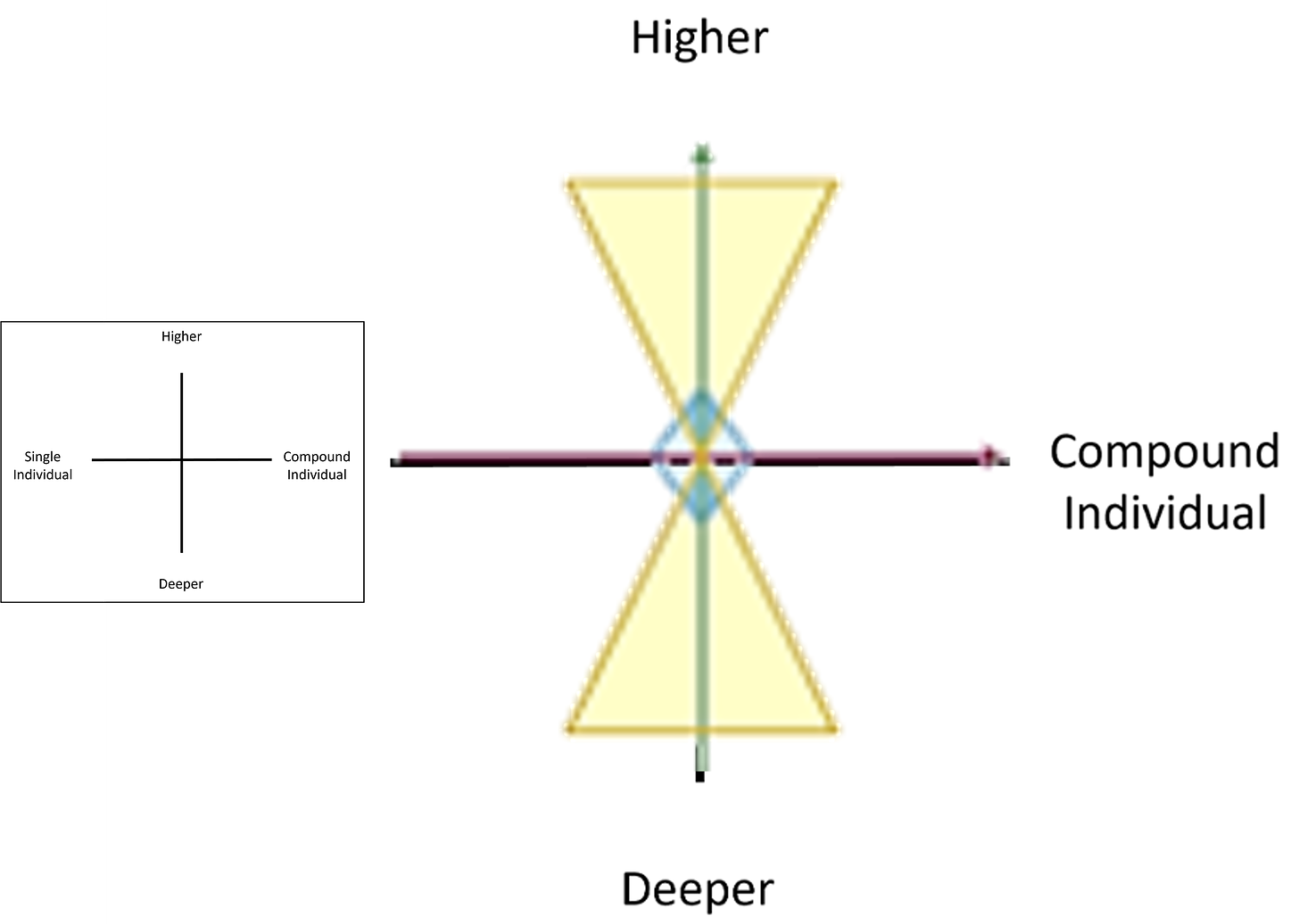
The term is borrowed from Michael Levin’s notion of cognitive lightcone, except the bowtie has two cones, one facing up, and one facing down. Any “single individual” participates with higher-order, collective intelligences, and with deeper-order, collective intelligences. Each “single individual” has a limited range of access in either direction. For example, I have participatory and cognitive access to social media, but I don’t have either participatory or cognitive access to the social life of my immune system. Whereas the society of immune cells have a very sophisticated communication, response and collective intelligence.
A Collective Insight Practice
This module is based on practicing collective insight by attending to this question of
What is the fundamental template of bodies in space that accounts for matter, mind, and human experience?
Here is a video showing my own process so far. It starts off describing the difference between a compound individual and a collective, through the notion of internal relations or “ingress.” Then I outline the larger conversation that will seed the insight practice.
Further Resources
Cohorts
Note that access requires a paid membership.